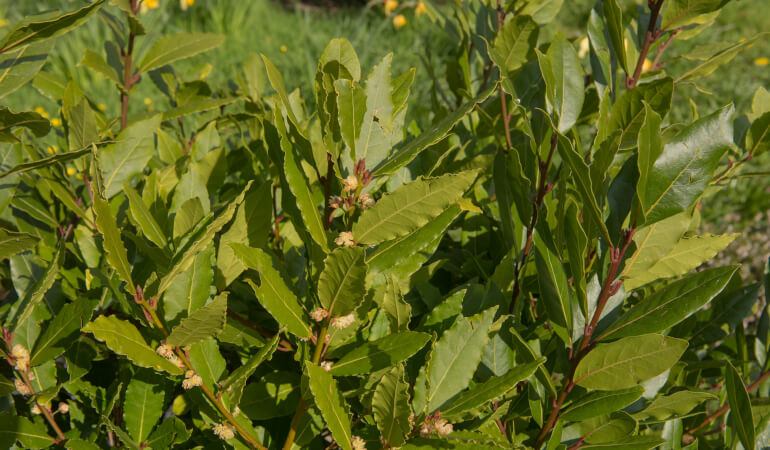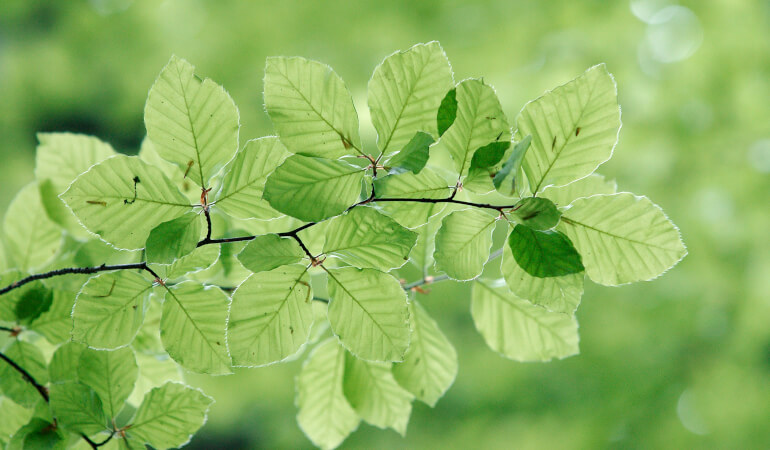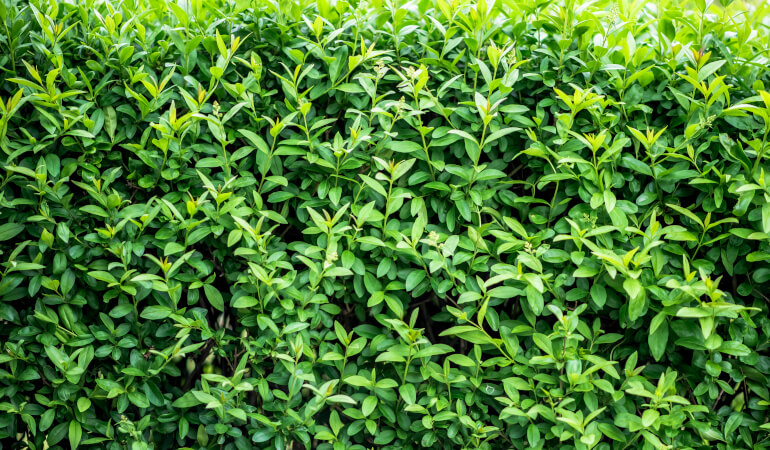
If you envision your garden as a secluded sanctuary where you can relax and enjoy some peace, it will be of great benefit to improve the privacy of that special place. One way to do that is by strategically planting different beautiful tall-growing plants. They will not only add a touch of botanical elegance but will also shield your outdoor area from curious eyes.
In this blog post, we’ll list the most appropriate tall outdoor potted plants and explore how they can meet your needs. So, let’s take a look and unveil the secrets of privacy in the United Kingdom’s garden wonderland.
Table of Contents
Best tall outdoor potted plants for privacy
It’s essential to choose the right tall plants for screening that flourish in our climate to create an inviting and private outdoor haven in the UK. Here’s a selection of tall plant species that are well-suited for UK gardens, each with its unique characteristics, growth habits, and care requirements:
Bamboo (Phyllostachys)

Characteristics
- Fast growth: Bamboo, particularly Phyllostachys varieties, is known for its rapid growth, making it one of the fastest-growing plants on Earth.
- Versatile species: Phyllostachys encompasses various species with diverse characteristics, including tall timber bamboo and smaller ornamental varieties.
- Culms and nodes: The bamboo culms (stems) are segmented by nodes, contributing to their distinctive appearance and flexibility.
Care
- Watering: Bamboo generally requires consistent moisture, especially during dry periods. The right amount of water helps maintain its lush and nice appearance.
- Fertilisation: Periodic fertilisation with a balanced, organic fertiliser supports healthy growth. Avoid excessive nitrogen usage, as it can lead to weak culms.
- Thinning and pruning: Thinning out old or weak culms and pruning the lower branches help maintain a neat and aesthetically pleasing appearance.
Placement and arrangement
- Sunlight: Most bamboo varieties thrive in full to partial sunlight.
- Spacing: Bamboo should be planted with consideration for its spreading rhizomes. Planting in containers or installing a rhizome barrier can help control its spread.
- Landscape design: Bamboo serves various purposes in landscaping, from creating privacy screens to adding an exotic touch. Choose species based on the desired height and appearance for your landscape design.
Yew (Taxus baccata)

Characteristics
- Evergreen foliage: Yew, or Taxus baccata, is an evergreen conifer with dark green, needle-like leaves that provide year-round interest.
- Slow growth: Yews are relatively slow-growing, making them suitable for hedges, topiaries, and ornamental features that require controlled size.
- Red berries: Female yew plants produce distinctive red berries, adding a splash of colour to the landscape. However, bear in mind that the berries if consumed can be toxic.
Care
- Pruning: Regular pruning helps maintain a desired shape and size. Yews respond well to shaping and can be pruned into formal hedges or more creative topiary forms.
- Soil and water: Yews prefer well-drained soil and benefit from regular watering, especially during dry periods. However, they tolerate a range of soil conditions once established.
- Disease resistance: Yews are generally hardy and resistant to many pests and diseases, which makes them a great option for low maintenance.
Placement and arrangement
- Sunlight: Yews are versatile and can tolerate both full sun and partial shade, although they often perform best in partial shade.
- Landscaping uses: Yews are commonly used as hedges, screens, or foundation plantings. Their dense foliage provides excellent privacy.
- Container planting: Dwarf varieties of yew are well-suited for container planting, adding an evergreen element to patios and decks.
Holly (Ilex aquifolium)

Characteristics
- Evergreen foliage: Holly, scientifically known as Ilex aquifolium, features glossy, dark green leaves that remain on the plant year-round, providing a continuous splash of colour.
- Berries: Female holly plants produce vibrant red berries in the fall and winter, adding a festive touch to the landscape.
- Varied forms: Holly comes in various forms, including upright, pyramidal, and compact varieties, offering flexibility for different landscape uses.
Care
- Pruning: Regular pruning helps maintain a dense and attractive shape. Prune in late winter or early spring to encourage new growth and control size.
- Soil and water: Holly prefers well-drained soil and benefits from regular watering, especially during dry spells. Mulching around the base helps retain moisture.
- Disease resistance: Generally hardy, holly is resistant to many pests and diseases, making it a relatively low-maintenance plant.
Placement and arrangement
- Sunlight: Holly thrives in full to partial sunlight. Consider the specific variety’s sunlight requirements when planning its placement in your landscape.
- Landscaping uses: Holly is versatile and can be used as a hedge, screen, foundation planting, or specimen plant. Its dense foliage provides excellent privacy.
- Seasonal interest: Use holly strategically in the landscape to provide winter interest, with its evergreen foliage and vibrant berries contributing to a visually appealing winter garden.
Bay Laurel (Laurus nobilis)

Characteristics
- Aromatic foliage: Bay Laurel, scientifically known as Laurus nobilis, features aromatic, dark green leaves that are commonly used as a culinary herb.
- Evergreen nature: This plant retains its foliage throughout the year, providing a consistent green presence in the landscape.
- Small yellow flowers: In spring, bay laurel produces small, inconspicuous yellow flowers, adding subtle charm to the plant.
Care
- Pruning: Regular pruning helps control the size and shape of the bay laurel. Trim as needed to encourage bushiness and remove any dead or damaged branches.
- Soil and water: Bay laurel prefers well-draining soil and regular watering. Allow the soil to dry out between waterings, as it is exposed to root rot in moist conditions.
- Container growth: Bay laurel adapts well to container growth, making it suitable for patios and balconies. Ensure the container has drainage holes.
Placement and arrangement
- Sunlight: Bay laurel thrives in full to partial sunlight. Place it in a location with at least six hours of direct sunlight for optimal growth.
- Indoor/outdoor use: Bay laurel is suitable for indoor and outdoor planting. It can be grown as a potted plant indoors or planted in the garden as part of a culinary herb bed.
- Companion planting: Consider placing bay laurel near other herbs or vegetables in the garden, as it can act as a natural pest deterrent.
Beech (Fagus sylvatica)

Characteristics
- Deciduous foliage: Beech, scientifically known as Fagus sylvatica, is a deciduous tree with medium to dark green leaves that turn coppery bronze in autumn before falling.
- Smooth bark: Young beech trees exhibit smooth, grey bark, while mature trees develop a distinctive, fissured bark that adds visual interest to the winter landscape.
- Nut production: Beech trees produce small triangular nuts encased in spiky husks, providing food for wildlife.
Care
- Pruning: Minimal pruning is typically required for beech trees. During the dormant season you can remove dead or damaged branches and shape the tree.
- Soil and water: Beech trees prefer well-drained soil and benefit from regular watering, especially during dry spells. Mulching around the base helps retain soil moisture.
- Protecting young trees: Young beech trees may benefit from protection against deer and rabbits, which may browse on the tender bark.
Placement and arrangement
- Sunlight: Beech trees thrive in full to partial sunlight. Plant them in a location with good sunlight exposure for optimal growth and fall colour.
- Landscape use: Beech trees make excellent specimen trees in parks and large gardens. You can use them to create allees, hedges, or as part of mixed temporary woodlands.
- Seasonal interest: Beech trees offer seasonal interest throughout the year, from fresh green foliage in spring to rich autumnal hues and unique winter bark patterns.
Privet (Ligustrum)

Characteristics
- Foliage variety: Privet, belonging to the Ligustrum genus, exhibits a range of foliage types, including evergreen and deciduous varieties. Depending on the specific cultivar leaves can be dark green, variegated, or golden.
- Compact growth: Privet is known for its dense and compact growth habit, forming a solid hedge or screen when planted closely together.
- Fragrant blooms: In late spring to early summer, privet produces small, fragrant flowers, usually in clusters. Their blooms attract pollinators and add a pleasant scent to the surrounding area.
Care
- Pruning: Regular pruning is crucial for shaping and controlling the size of privet hedges. It responds well to pruning and can be maintained in formal shapes or left more natural.
- Soil and water: Privet is adaptable to different soil types but thrives in well-drained soil. Provide consistent watering, especially during dry spells. Mulch to retain soil moisture.
- Pest resistance: Privet generally resistant to pests and diseases, is a hardy and low-maintenance plant.
Placement and arrangement
- Sunlight: Privet thrives in full to partial sunlight. Plant it in locations with at least four to six hours of direct sunlight for optimal growth.
- Hedging and screening: Privet is commonly used for creating hedges and screens due to its dense foliage, providing privacy and acting as a barrier against wind.
- Versatile landscaping: Privet is versatile and can be used in various landscape settings, from formal gardens to more relaxed and naturalistic arrangements.
Lavender (Lavandula)

Characteristics
- Fragrant foliage: Lavender, from the Lavandula genus, is renowned for its aromatic, grey-green foliage that releases a delightful scent when touched.
- Spike-like blooms: Lavender produces spikes of small, tubular flowers in shades of purple, blue, pink, or white, attracting pollinators like bees and butterflies.
- Compact growth: Lavender typically forms compact, bushy mounds, making it suitable for borders, containers, and herb gardens.
Care
- Pruning: Regular pruning after flowering helps maintain a neat shape and encourages new growth. Cutting back one-third of the plant in early spring stimulates vigorous blooming.
- Well-drained soil: Lavender thrives in well-drained, slightly alkaline soil. Amend soil with sand or gravel to improve drainage if needed.
- Sunlight: Lavender loves full sunlight. For optimal growth and flowering it needs at least 6-8 hours of direct sunlight daily.
Placement and arrangement:
- Border planting: Lavender makes an excellent border plant, creating a fragrant and visually appealing edge in garden beds.
- Rock gardens: Its compact growth and preference for well-drained soil make lavender well-suited for rock gardens or container gardening.
- Edging and paths: Plant lavender along pathways or near seating areas to enjoy its fragrance when brushed against or crushed underfoot.
Rhododendron

Characteristics
- Evergreen or deciduous: Rhododendrons encompass both evergreen and deciduous varieties, offering year-round foliage or seasonal changes in appearance.
- Showy blooms: Rhododendrons have blooms in different hues like shades of pink, purple, red, white, and more. They have spectacular, large, and colourful flowers.
- Leathery leaves: Rhododendron leaves are often leathery and may be glossy or matte, contributing to the plant’s lush and attractive appearance.
Care
- Acidic soil: Rhododendrons prefer acidic soil with good drainage. Maintain moisture and acidity by improving the solid with organic matter and mulching.
- Pruning: Prune after flowering to shape the plant and remove spent blooms. Avoid heavy pruning, as rhododendrons form buds for the next year’s flowers shortly after blooming.
- Watering: Consistent watering is crucial for rhododendrons, especially during dry spells. Retain soil moisture and regulate temperature by regular mulching.
Placement and arrangement:
- Shade tolerance: Rhododendrons thrive in partial to full shade, making them ideal for woodland gardens or areas with dappled sunlight.
- Foundation planting: Use rhododendrons as foundation plants to add structure and vibrant colour to the landscape around homes and buildings.
- Mass planting: Create stunning displays by planting rhododendrons in groups or clusters, enhancing their visual impact and creating a focal point in the garden.
Legal restrictions to consider when enhancing your garden’s privacy
When using tall garden plants for privacy in the UK, make sure you are aware of any potential legal restrictions or regulations that may apply. Potted plants are a perfect way to enhance your outdoor space, however, there are a few considerations to keep in mind:
Planning permissions
In some cases, erecting structures or installing fencing for privacy may require planning permissions. The good news is that potted plants are often considered a more temporary and less intrusive solution. Still, ensure you comply with any regulations that may apply to your location. Check with your local council or planning department.
Property boundaries
Ensure that the placement of your potted plants respects property boundaries and does not infringe on your neighbours' land. Property disputes can be avoided by clearly defining and respecting boundaries.
Homeowner associations
If you live in a community governed by a homeowner association, there may be specific rules and guidelines regarding outdoor alterations, including using screening plants for privacy. Review your homeowner association's bylaws and consider consulting with them (if necessary) to ensure your plans align with their regulations.
Protected species
Be aware of any protected plant species in your area. In the UK, some plants are protected by law, and it's essential to avoid harming or disturbing these species when choosing and caring for your tall potted plants.
Benefits of using tall outdoor potted plants for privacy
Tall outdoor potted plants can be your secret weapon when creating solitude; they offer many benefits that traditional privacy screens or fences often can't match. Let's discover why potted plants are the perfect solution for your garden.
- Versatility and mobility – Unlike permanent structures like fences or screens, potted plants provide you with the flexibility to rearrange and reposition them at your leisure. Whether hosting an outdoor gathering or simply seeking a change in scenery, plants for privacy can quickly adapt to your needs. This versatility is especially advantageous for those with limited garden space.
- Aesthetic appeal – Tall potted plants not only provide privacy but also contribute to the visual charm of your garden. The lush greenery and vibrant colours of various plant species enhance the overall aesthetics of your outdoor space. They create a soothing, natural atmosphere, inviting you to relax in your resting area. Your garden will not only feel more secluded but also more beautiful.
- Well-being – Tall plants for screening add a layer of privacy while simultaneously promoting a sense of calm and tranquillity. In a world where urbanisation is rising, and garden spaces are shrinking, this is a valuable benefit that should be considered.
Need a professional gardener?
Enter your postcode to view our rates and availability in your area.
For questions about the services we offer visit our main site
Takeaways
- In the UK, where urbanisation has diminished our private outdoor spaces, tall outdoor potted plants offer a versatile solution.
- Their versatility, aesthetic appeal, and adaptability make them ideal for adding privacy to your garden.
- Thoughtfully placing and caring for these plants can help you create a personal oasis.
- Be sure to consider any legal regulations in your area.
- Choose a tall outdoor potted plant that fits perfectly into your available garden space and has care requirements you can easily cover.




Bamboo, in particular, grows quickly and can form a dense screen when planted in large pots. It’s important to choose a clumping bamboo variety to prevent invasive spreading. Arborvitae, with its dense foliage, is another favorite of mine for creating a natural barrier. These evergreens thrive in containers and can be trimmed to maintain their height and shape.
Thank you for sharing such valuable insights in the article